"Winter Thunderstorm." H. 2
The troops of the Stalingrad and South-Western Fronts were tasked with eliminating the enemy’s attempts to break through to the Paulus group.
The position of the Soviet troops
The Red Army was originally faced with two main tasks: 1) the destruction of the surrounded Stalingrad Wehrmacht group; 2) carry out a rapid attack on the external front of the environment in the general direction of Rostov.
The Soviet High Command decided without any pause to carry out an operation to destroy the surrounded 6th German Field and part of the 4th tank armies. The fulfillment of this task was entrusted to the Don forces and the main forces (62nd, 64th and 57th armies) of the Stalingrad fronts. On November 24, 1942, fierce battles were fought with the enemy surrounded, who offered stubborn resistance and turned into counterattacks. The territory occupied by the army of Paulus by November 29 was reduced by almost half and amounted to only 1500 square meters. km The encirclement area did not exceed 70–80 km in a straight line from west to east and 30–40 km from north to south. However, the offensive of the Soviet troops from November 24 to 30 was slow and did not solve the main tasks assigned to the fronts. It turned out to be insufficient for the disintegration of the enemy group and its liquidation into parts of the available forces of the Don and Stalingrad fronts.
Subsequently, A. M. Vasilevsky noted that the decision of the Stake on the destruction of the German group surrounded by the German group in the Stalingrad region proceeded from an incorrect assessment of its numerical strength. “According to intelligence data from the fronts that took part in the counteroffensive, as well as the intelligence agencies of the General Staff, the total number of the surrounded group, commanded by Colonel General Paulus, was determined at that time in 85 — 90 thousand people. In fact, it counted, as we learned later, more than 300 thousand. Our ideas about military equipment, especially artillery and tanks, and armament, which surrounded fascists had, were significantly underestimated. Intelligence could not detect and take into account all the replenishment that the Stalingrad grouping of the Wehrmacht received during the battle for Stalingrad, as well as numerous units and subunits of various special and auxiliary services. The personnel of these troops, also caught in the "boiler", was used by the German command to replenish combat units. Among them were the Air Defense Division, more than ten separate engineer battalions, sanitary units, construction battalions, engineering detachments, units of field gendarmerie, secret military police, etc.
Essential was the fact that the length of the defense line of the German army under the conditions of encirclement was significantly reduced, and the battle formations were tightened. The German command took measures to create a strong defense in the neighborhood. The enemy forces combined in the 6 Army (seventeen divisions of the 6 Army and five divisions of the 4 Army Tank Army) occupied a solid defense to the west and south-west of Stalingrad on the front of Orlovka, Tsybenko, Kuporovoe with a total length of about 170 km. Army headquarters was in the village. Gumrak - the center of a surrounded group.
In addition, in late November - early December, the balance of forces on the inner front of the environment did not change in favor of the Red Army. The creation of the external front of the environment, especially in the south-western and southern directions, was carried out at the expense of troops removed from the inner ring. “It was all the more necessary,” noted A. Vasilevsky, “that we began to receive information about the transfer of additional troops from the other sectors of the Soviet-German front and from Western Europe to the Stalingrad direction. In the last days of November, we were forced to regroup from the internal to the external front, to strengthen the Tormosinsky direction, a number of infantry divisions of the 65 and 21th armies of the Don front, and to the Kotelnikov direction — the infantry divisions of the 51th army of Stalingrad front ". As a result, by the 1 of December 1942, the ratio of forces and equipment was as follows: the Soviet troops had 480 thousand people on the domestic front, 465 tanks, 8490 guns and mortars (without anti-aircraft artillery and 50 mm mortars), and surrounded Germans - about 330 thousand people, 340 tanks, 5230 guns and mortars. Thus, the Soviet troops did not have a decisive superiority in manpower, tanks and guns, in order to crush the enemy straight off.
In the air in the Stalingrad direction, the Soviet command had 790 front-line combat aircraft aviation, as well as a number of long-range aviation units. At the same time, 540 aircraft were used against the encircled group, and 250 on the external front. The Germans had 1070 aircraft of the 4th air fleet and the 8th air corps. However, the German command was forced to use a significant part of fighter aviation to cover transport aircraft supplying the encircled troops.
Simultaneously with the liquidation of the Wehrmacht’s surrounded Stalingrad group, the Supreme Command decided to conduct an operation on the Middle Don (codename Saturn) in order to defeat the main forces of the Italian 8 Army, the Hollidt Task Force, remnants of the Romanian 3 Army and develop a counter-offensive against the Stalingrad Rostov direction. Preparation of the operation began in late November.
The preparation of the operation to eliminate the Paulus group continued. The rate considered it important to solve this problem as soon as possible. November 27 Supreme Commander Joseph Stalin in a conversation on a direct wire with A. M. Vasilevsky and the commander of the South-Western Front paid particular attention to this issue: "The enemy troops at Stalingrad are surrounded, they must be eliminated in order to free our whole three armies ... It is very important business, more important business than the operation "Saturn". " Stalin paid special attention to the concentration of aviation forces to defeat the enemy.
Vasilevsky, fulfilling Stalin's instructions, on November 30, set the task for the front commanders to resume offensive operations on the internal front of the encirclement to dismember and destroy the Stalingrad group. The commander of the Don Front, Lieutenant-General K. K. Rokossovsky decided to deliver the main attack of the front with the forces 21, 65 and 24 armies in the sector Karpovka, Baburkin. For this, it was necessary to conduct a preliminary private operation to destroy the enemy in the area of Karpovka, Dmitrievka, Marinovka and reach the line of the r. Rossoshki, deploying troops here to attack in the general direction of Gumrak. The commander of the Stalingrad Front, Colonel-General A. I. Eremenko, planned to deliver the main blow by the forces of the 62 and 64 armies in the direction of Alekseyevka. The actions of both fronts were to lead to the dismemberment and then liquidation of the Paulus group. The command of the fronts from 1 to 3 December made a partial regrouping of forces, reinforcing the external front of the environment and ensuring the upcoming operation from the west and south of the enemy's possible counter attacks, 51-I, 57-i armies and all reserves of the Stalingrad Front were aimed to solve this problem. Thus, the troops of the 51 Army were to advance in the direction of Kotelnikovo, the 4 th mechanized corps was to be sent to Yermohinsky.
For the organization of a reliable blockade of the army of Paulus, measures were taken from the air, which had previously not been given due attention. “Frankly speaking,” wrote M. Vasilevsky, “at first, at least until December 1942, we underestimated the seriousness of this task, and its implementation was random, scattered: the work of aviation with the anti-aircraft artillery fire system , there was no clear control and interaction between them. But the enemy had at least 5 completely suitable aerodromes, which simultaneously received a significant number of aircraft. The reserves of food, ammunition and fuel, which had been drastically reduced every day, the need to evacuate a huge number of wounded and sick, forced the Hitlerite command to attract a maximum of aircraft to transport traffic, and to use even bombers for that.
It was only in the first half of December that our command paid more serious attention to the destruction of the German air bridge, which was supplied by the German 6. A rather harmonious system was developed for using aviation as well as artillery in the fight against enemy transport aircraft. Established strict responsibility for the order of destruction of enemy aircraft with clarification of the duties of the troops of the outer ring and the inner ring of the environment - the aircraft were destroyed when approaching the ring and during loading and take-off. Our fighters got the opportunity to act around the clock. Long-range artillery was used to destroy enemy aircraft on airfields and landing sites inside the ring of the environment. In addition, the work of various forces and assets that were used to combat the enemy’s transport aircraft was linked by a unified monitoring, warning and communication system. All this, taken together, made it possible to drastically reduce the flow of cargo that went along the “air bridge” into the surrounded army and the removal of certain specialists and the wounded.
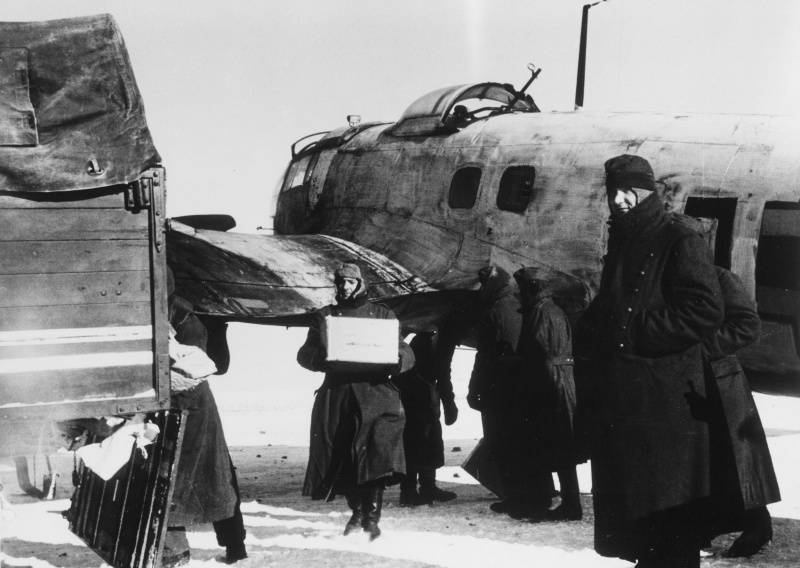
German soldiers unload He.111 aircraft at one of the airfields near Stalingrad
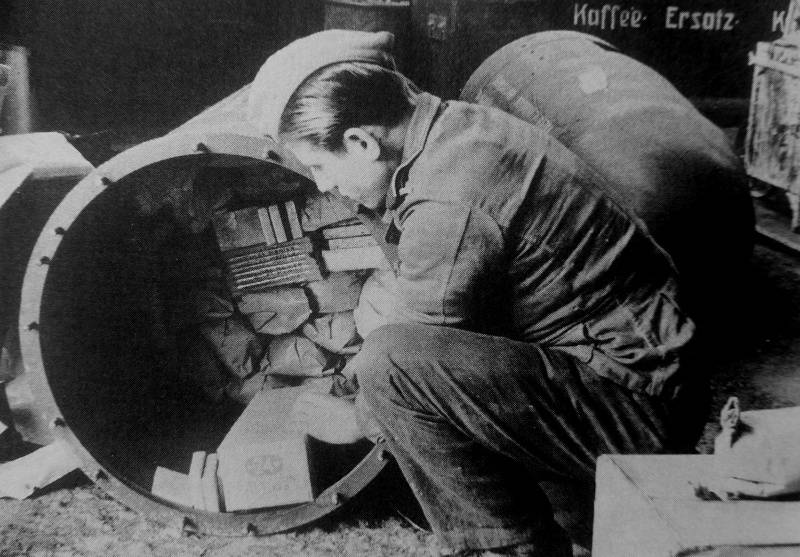
German soldiers in freight containers prepared to supply the German units in Stalingrad. 1942 — 1943
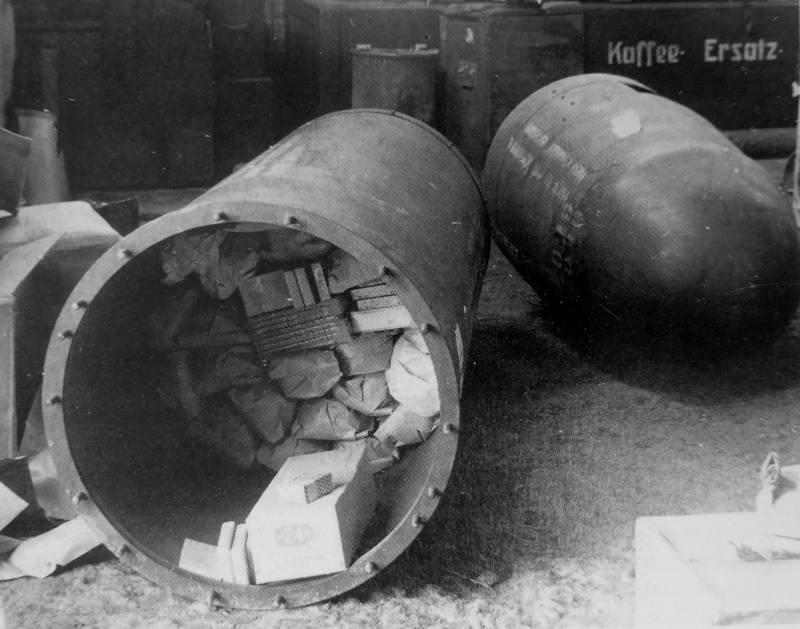
German freight containers prepared to supply parts encircled in Stalingrad
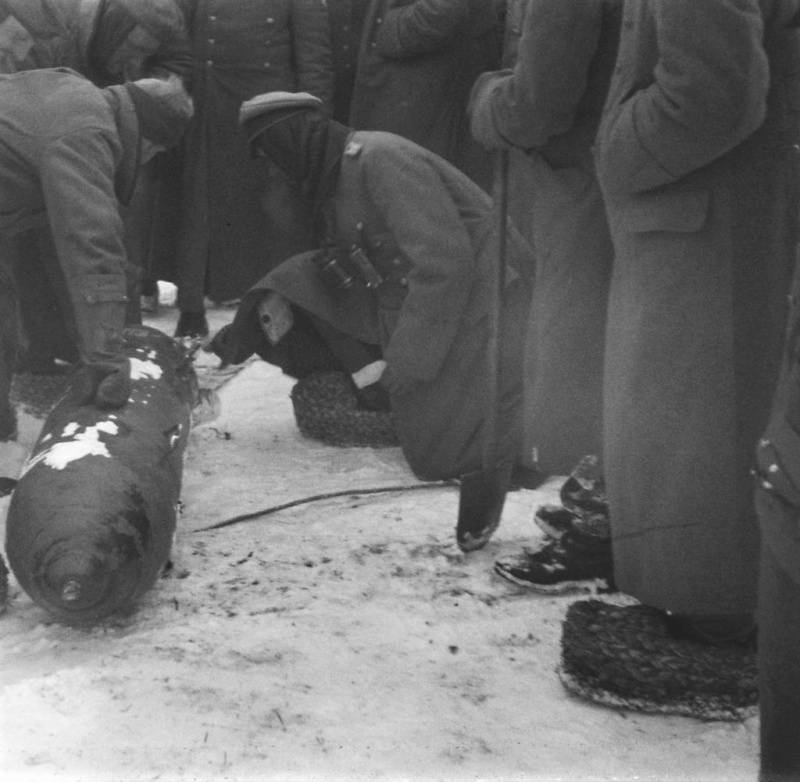
The Wehrmacht 6 Army servicemen are inspecting an aircraft container in Stalingrad surrounded
The troops of the Don and Stalingrad fronts in the first days of December attacked the enemy on the internal front of the encirclement. However, the Germans stubbornly fought back and our troops did not achieve significant success. The enemy organized a strong defense on the new frontiers, using the previously created Soviet defensive lines. In addition, the balance of forces on the internal front of the environment has again changed in favor of the enemy. The alarming situation in the southern and southwestern sectors of the external front forced us to constantly strengthen these areas. Some of the connections were transferred there. As a result of partial regrouping of the Don and Stalingrad fronts from 1 to 3 December, they had thousands of people and 4 tanks by December 300 on the internal front, and the enemy also had about 312 thousand people and 300 tanks. That is, the balance of power has changed here is not in favor of the Soviet army. With the available forces she could not crush the enemy entrenched in the Stalingrad fortified area.
Our troops continued their attacks and achieved small successes. The troops of the Stalingrad Front advanced in the Kuporovoe area, the 65 Army of the Don Front reached the line of the r. Rossoshka, and the 21-I army of this front achieved a small advance north-west of Karpovka. The Germans, relying on a powerful line of defense, during the nine-day fierce fighting in general, successfully held. Now it was the opposite, the Germans defended, and our troops went to the assault, literally gnawing the defense of the enemy. Thus, it finally became clear that it was impossible to liquidate the Paulus group by forces.
Soviet Stake 8 December decided to more thoroughly prepare the operation to destroy the Stalingrad Wehrmacht group, regroup the troops, strengthen them at the expense of reserves, and improve the material and technical support of the operation (ammunition, fuel). December 9 The 5 shock army was formed under the command of Lieutenant General M. M. Popov. A new army unfolded between the 51-th army of the Stalingrad Front and the 5-th tank army of the South-Western Front in the area from the mouth of the r. Liski to Verkhne-Rubizhny. A bit later, the 2-I Guards Army under the command of Lieutenant-General R. Ya. Malinovsky was transferred to the Stalingrad area. It has become the most powerful striking force in this area. By December 18 it was planned to complete the preparation of a new offensive operation against the enemy grouping encircled near Stalingrad.
The headquarters originally planned to use the 2-th Guards Army as part of the forces of the South-Western Front to develop the offensive (according to the plan of Operation Saturn) from the Kalach area in the direction of Rostov-Taganrog. However, the delay in the liquidation of the surrounded army of Paulus and the heightened threat of an attempt to de-blockade it with the help of the forces of the “Don” army group forced us to reconsider the original intentions. Due to a change in the situation at the front, the General Headquarters sent the 2 th Guards Army to the command of the Don Front. The loading of army units into trains to go to the front began in early December. Unloading was carried out north-west of Stalingrad. The first echelons began to arrive at the December unloading sites of 10 and immediately went to the area of concentration - the nagging, the sandgun.
On December 9, the command of the Don and Stalingrad fronts presented to GHQ a new plan for the operation to eliminate the surrounded enemy grouping. Stalingrad grouping planned to destroy in three stages. At the first stage, the forces of the Don Front destroy four infantry divisions west of the Rossoshka River; at the second stage, with the impact of the Don Front, mainly the 2 Guards Army, in the south-east direction on Voroponovo, and the counter blow of the 64 Army of the Stalingrad Front through Peschanka, also isolate Voroponovo, and then force the southern part of the surrounded group to capitulate; at the third stage, by striking all the armies of the Don and Stalingrad fronts operating on the domestic front in the general direction of Gumrak, finally break the resistance of the surrounded enemy and end it.
11 December The rate basically approved the plan of operation “Ring”, only the tasks envisaged at the first two stages of the operation should have been solved at the first stage. The operation was planned to start on December 18 and complete the rout of the enemy group no later than December December 23.
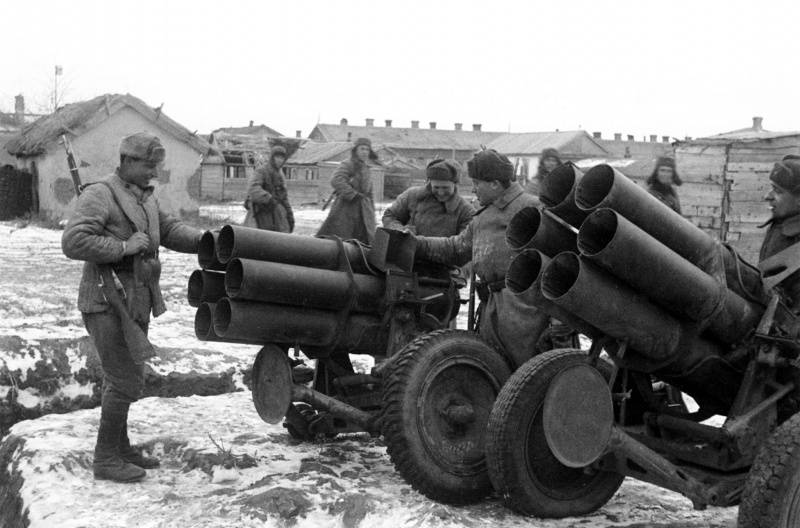
Gunners - Guards inspect captured German 150-mm six-barreled mortar "Nebelverfer" 41 (15 cm Nebelwerfer 41) on the Stalingrad front
Fights on the outer ring of the environment
2 December 1941, the troops of the 5 tank army attacked the enemy and, as a result of fierce fighting, captured the bridgehead on the river Chir in the area of Nizhne-Kalinovka. 3-6 December, our troops in this sector reflected the counterattacks of the 336 th infantry, 11 th tank and 7 th enemy airfield divisions. 7 December 5-I tank army resumed the offensive, forced the river. Cheer The troops of its left flank seized Ostrovsky, Lisinsky and state farm number 70. During the stubborn battle in the Surovikino, Ostrovsky, Lisinsky sector, the enemy managed to stop the advance of the Soviet troops. In the following days, the Germans with strong counterstrikes pushed the troops of the 5 tank army to the starting line.
Thus, the German army kept a bridgehead on the left bank of the Don near Nizhne-Chirskaya, as well as bridgeheads on the left bank of the r. Chir in the area Rychkovsky and Upper-Chirsky. However, the blow of the Soviet 5 tank army exhausted enemy forces in this direction, and the German command was forced to abandon a counterattack from the Tormosin-Nizhne-Chirskaya area in order to release Paulus's troops.
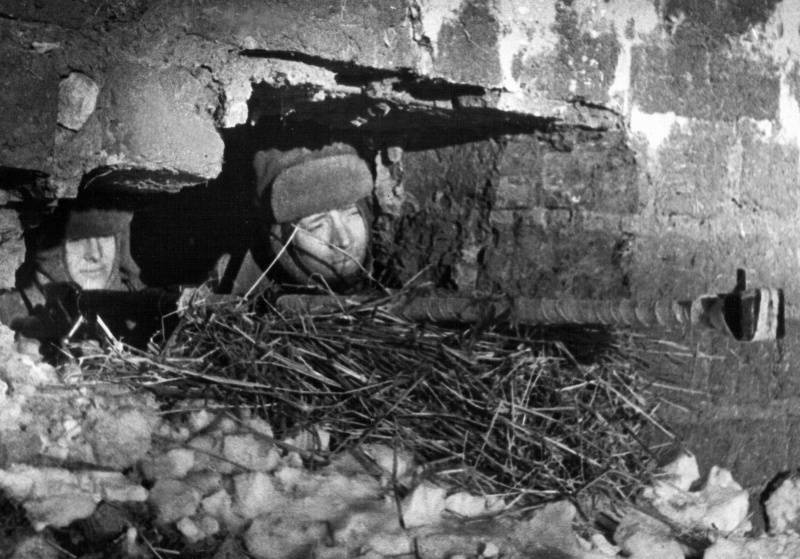
Soviet armored fighters N. Seregin and A. Bakayev with an anti-tank rifle disguised in a destroyed building, waiting for German tanks near Stalingrad
The location of the Soviet armies and their strength
On the Stalingrad front, the troops of the 62, 64 and 57 armies improved their positions on the 95-kilometer stretch from the Market to the Prudboy junction and prepared for an offensive against the enemy's surrounded army.
The 5 shock, the 51 and 28 armies acted on the external front with a total length of 365 km (to Elista and Astrakhan). The command of the Stalingrad Front, in order to strengthen its troops in the Kotelnikovo direction, transferred from the left bank of the Volga from its reserves 300 and 87 rifle divisions, which advanced units to Buzinovka, Zetas, Upper Tsaritsyn areas in the morning of December. And the 12-th rifle division was concentrated in the area of the “Krep” state farm, and in the Passion area — the 315-I flamethrower tank brigade, the 235-th separate tank regiment and the 234-I fighter brigade. To strengthen the troops on the external front, the 20-th mechanized and 4-th tank corps were sent here from the internal front.
On the external front, the troops of the 5 Shock Army opposing the enemy grouping in the Nizhny Chirskaya region had the highest density. Occupying a defense on the front to 95 km, the army consisted of 71 thousand people, 252 tank, 814 guns and mortars. The forces and equipment of the 51 Army, which was defensive in the area about 140 km, were much weaker. The army had 34 thousand people, 77 tanks, 419 guns and mortars. The operational density in the army band was only one division per 28 km of front, 0,5 tank and about 3 guns and mortars on 1 km of front. Divisions numbered an average of 4 thousand people, in the companies there were only 30 - 35 people. The 28 Army had 44 thousand people, 40 tanks, 707 guns and mortars. The army defended at the front up to 130 km. The material support of the 5 shock and 51 armies was inadequate, especially with regard to ammunition and fuel.
The 5 th infantry, 336 th airfield and 7 th tank divisions of the enemy acted in front of the 11 th shock army sector. The 51 army was opposed by the enemy 10 divisions, and the 28 army in the area of Elista was the German 16 motorized division. In the area of Tormosin was 17-I tank division - a reserve of the army group "Don".
Field Marshal Manstein decided, without waiting for the grouping to be concentrated in the Tormosin area, to launch an offensive with the forces of one Kotelnikov group (the Goth army group). The breakthrough of the front of the encirclement of the Soviet troops from here was planned by striking a narrow section of the front along the Tikhoretsk-Stalingrad railway. The Soviet Stavka unraveled the enemy’s plan and took measures to repel the attacks prepared by the enemy from the Kotelnikovo area and from the bridgehead near Nizhne-Chirskaya. The possibility of a counterstrike from the ring of the environment was also taken into account.
The bid temporarily postponed the operation to destroy the surrounded Stalingrad group. The troops of the Stalingrad and South-Western Fronts were tasked with eliminating the enemy’s attempts to break through to the Paulus group and restore their positions at Stalingrad. To consolidate the position of the troops of the Stalingrad Front from the south, operating against the Kotelniki grouping, the 2-I Guards Army was sent there. In order to prevent joint actions by the Kotelnikovsk and Lower-Chirsk enemy groupings, it was decided by the forces of the 5 shock army to liquidate the enemy bridgehead in the area of the Rychkovsky hamlet. The 5 Tank Army was to promote the offensive.
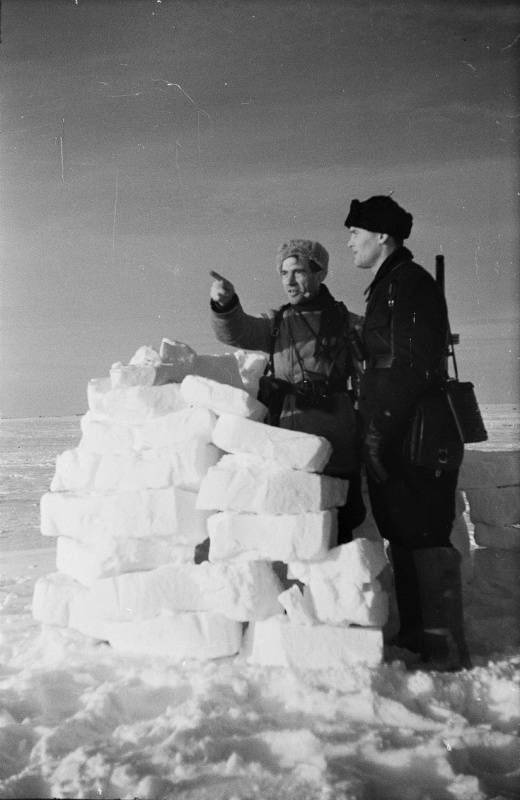
Soviet officers are monitoring the enemy from a shelter, built of dense snow, near Stalingrad
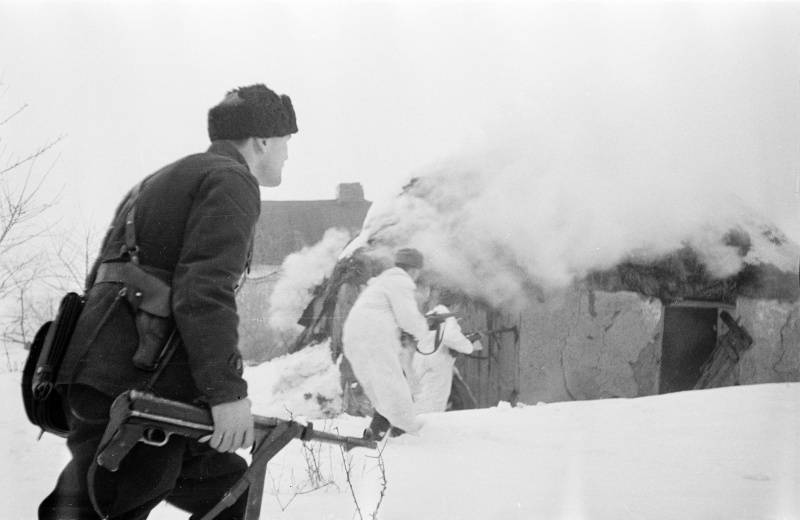
Soviet soldiers in battle at the village hut in the area of Stalingrad. The officer in the foreground is armed with a captured German submachine gun MP-40
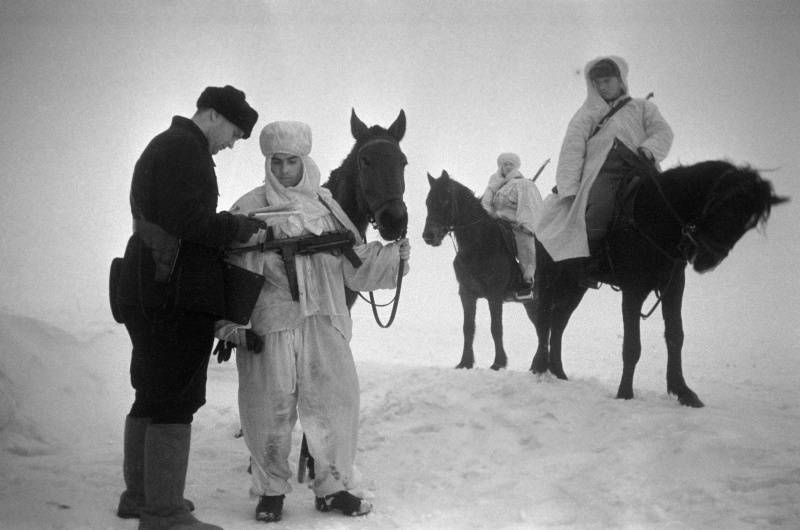
Soviet equestrian scouts receive an assignment from the commander in the steppe near Stalingrad. Photo source: http://waralbum.ru/
To be continued ...
Information